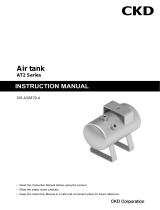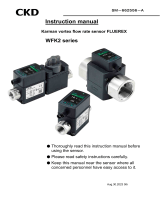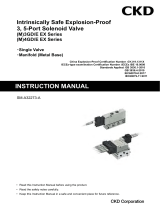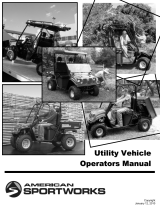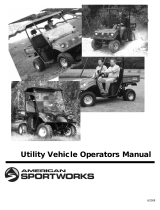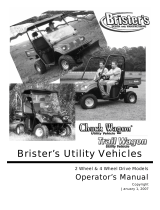Page is loading ...

INSTRUCTION MANUAL
INSTRUCTION MANUAL
• Read this Instruction Manual before using the product.
• Read the safety notes carefully.
• Keep this Instruction Manual in a safe and convenient place for future reference.
SM-50704-A/2
SM-358642
MODULE COOLANT VALVE
GCVE2 Series
GCVSE2 Series (Solenoid Valve Mounted)

SM-50704-A/2 PREFACE
i 2020-03-20
PREFACE
Thank you for purchasing CKD's "GCVE2 Series/GCVSE2 Series" module coolant valve.
This Instruction Manual contains basic matters such as installation and usage instructions in order to
ensure optimal performance of the product. Please read this Instruction Manual thoroughly and use the
product properly.
Keep this Instruction Manual in a safe place and be careful not to lose it.
Product specifications and appearances presented in this Instruction Manual are subject to change
without notice.
• The product, which uses control valves such as solenoid valves, motor valves, and air operated
valves, is intended for users who have basic knowledge about materials, fluids, piping, and
electricity. CKD shall not be responsible for accidents caused by persons who selected or used the
product without knowledge or sufficient training with respect to control valves.
• Since there are a wide variety of customer applications, it is impossible for CKD to be aware of all of
them. Depending on the application or usage, the product may not be able to exercise its full
performance or an accident may occur due to fluid, piping, or other conditions. It is the responsibility
of the customer to check the product specifications and decide how the product shall be used in
accordance with the application and usage.

SM-50704-A/2 SAFETY INFORMATION
ii 2020-03-20
SAFETY INFORMATION
When designing and manufacturing any device incorporating the product, the manufacturer has an
obligation to ensure that the device is safe. To that end, make sure that the safety of the machine
mechanism of the device, the pneumatic or water control circuit, and the electric system that controls
such mechanism is ensured.
To ensure the safety of device design and control, observe organization standards, relevant laws and
regulations, which include the following:
ISO 4414, JIS B 8370, JFPS 2008 (the latest edition of each standard), the High Pressure Gas Safety
Act, the Industrial Safety and Health Act, other safety rules, organization standards, relevant laws and
regulations
In order to use our products safely, it is important to select, use, handle, and maintain the products
properly.
Observe the warnings and precautions described in this Instruction Manual to ensure device safety.
Although various safety measures have been adopted in the product, customer's improper handling may
lead to an accident. To avoid this:
Thoroughly read and understand this Instruction Manual
before using the product.
To explicitly indicate the severity and likelihood of a potential harm or damage, precautions are classified
into three categories: "DANGER", "WARNING", and "CAUTION".
DANGER
Indicates an imminent hazard. Improper handling will cause death or serious
injury to people.
WARNING
Indicates a potential hazard. Improper handling may cause death or serious
injury to people.
CAUTION
Indicates a potential hazard. Improper handling may cause injury to people or
damage to property.
Precautions classified as "CAUTION" may still lead to serious results depending on the situation.
All precautions are equally important and must be observed.
Other general precautions and tips on using the product are indicated by the following icon.
Indicates general precautions and tips on using the product.

SM-50704-A/2 SAFETY INFORMATION
iii 2020-03-20
Precautions on Product Use
WARNING
The product must be handled by a qualified person who has extensive knowledge and
experience.
The product is designed and manufactured as a device or part for general industrial machinery.
Use the product within the specifications.
The product must not be used beyond its specifications. Also, the product must not be modified
and additional work on the product must not be performed.
The product is intended for use in devices or parts for general industrial machinery. It is not
intended for use outdoors or in the conditions or environment listed below.
• In applications for nuclear power, railroad system, aviation, ship, vehicle, medical equipment,
and equipment that directly touches beverage or food.
• For special applications that require safety including amusement equipment, emergency
shut-off circuit, press machine, brake circuit, and safety measures.
• For applications where life or properties may be adversely affected and special safety measures
are required.
(Exception is made if the customer consults with CKD prior to use and understands the
specifications of the product. However, even in that case, safety measures must be taken to avoid
danger in case of a possible failure.)
Do not handle the product or remove pipes and devices until confirming safety.
• Inspect and service the machine and devices after confirming the safety of the entire system.
Also, turn off the energy source (air supply or water supply) and power to the relevant facility.
Release compressed air from the system and use extreme care to avoid water or electric
leakage.
• Since there may be hot or live parts even after operation has stopped, use extreme care when
handling the product or removing pipes and devices.
• When starting or restarting a machine or device that incorporates pneumatic components, make
sure that a safety measure (such as a pop-out prevention mechanism) is in place and system
safety is secured.
Precautions on Product Disposal
CAUTION
When disposing of the product, comply with laws pertaining to disposal and cleaning of
wastes and have an industrial waste disposal company dispose of the product.

SM-50704-A/2 1.
iv 2020-03-20
CONTENTS
PREFACE ........................................................................................................................... i
SAFETY INFORMATION .................................................................................................. ii
Precautions on Product Use .......................................................................................... iii
Precautions on Product Disposal .................................................................................. iii
CONTENTS ...................................................................................................................... iv
1. PRODUCT OVERVIEW ............................................................................................. 1
1.1 Model Number Indication .................................................................................... 1
1.2 Internal Structure ................................................................................................ 2
1.3 Module configuration .......................................................................................... 4
2. INSTALLATION ......................................................................................................... 5
2.1 Environment ........................................................................................................ 5
2.2 Unpacking ........................................................................................................... 6
2.3 Mounting ............................................................................................................. 6
2.4 Piping .................................................................................................................. 7
2.5 Wiring .................................................................................................................. 9
2.5.1 How to wire the DIN terminal box ................................................................. 10
3. USAGE ..................................................................................................................... 12
3.1 Checks to Make Before Use (Checks Made After Mounting) ........................... 13
3.2 Safety Instructions ............................................................................................ 14
3.3 Manual Operation ............................................................................................. 15
4. MAINTENANCE AND INSPECTION ....................................................................... 16
4.1 Maintenance Parts ............................................................................................ 16
4.2 Periodic Inspection............................................................................................ 16
4.3 Disassembling and Assembling ........................................................................ 17
4.3.1 Disassembling .............................................................................................. 17
4.3.2 Assembling ................................................................................................... 17
5. TROUBLESHOOTING............................................................................................. 19
5.1 Problems, Causes, and Solutions .................................................................... 19
6. WARRANTY PROVISIONS ..................................................................................... 20
6.1 Warranty Conditions ......................................................................................... 20
6.2 Warranty Period ................................................................................................ 20

SM-50704-A/2 1. PRODUCT OVERVIEW
1 2020-03-20
1. PRODUCT OVERVIEW
1.1 Model Number Indication

SM-50704-A/2 1. PRODUCT OVERVIEW
2 2020-03-20
1.2 Internal Structure
◼ Internal structure for 0.5MPa, 1MPa
No.
Part name
Quantity
1
Cylinder cover
1
2
Spring
2
3
Piston assembly
1
4
PSD packing
1
5
C-type stop ring
1
6
O-ring
1
7
Adaptor
1
8
O-ring
1
9
Body
1
10
Pilot solenoid valve
1
11
O-ring
1
12
Rod packing
1
13
Scraper
1
14
O-ring
1
15
Roll pin
1
16
Thrust washer
1
17
Main valving element
1
18
Hexagon socket head cap screw
4
* The figure above shows GCVSE2(normally closed type). Normally open type has the spring below the piston.
* GCVE2 is not equipped with (13) pilot solenoid valve.

SM-50704-A/2 1. PRODUCT OVERVIEW
3 2020-03-20
◼ Internal structure for 1.6MPa
No.
Part name
Quantity
1
Cylinder cover
1
2
Spring
2
3
Piston assembly
1
4
Wearing
1
5
PSD packing
1
6
C-type stop ring
1
7
O-ring
1
8
Adaptor
1
9
O-ring
1
10
Body
1
11
Pilot solenoid valve
1
12
O-ring
1
13
Rod packing
1
14
Rod packing
1
15
Scraper
1
16
O-ring
1
17
Thrust washer
1
18
Main valving element
1
19
Hexagon socket head cap screw
4
* The figure above shows GCVSE2(normally closed type). Normally open type has the spring below the piston.
* GCVE2 is not equipped with (13) pilot solenoid valve.

SM-50704-A/2 1. PRODUCT OVERVIEW
4 2020-03-20
1.3 Module configuration
●This product adopts the method to fix each module with the seal doing and the hex-head hole addition
bolt in O-ring for connection.
The body shape is A:Thread type and B:Through hole type.
The composition of each number of each ream is shown below.
Diagram of connections
◼ How to distinguish A type(Thread) and B type(Through hole)
The OUT port screw processing shape is different.
A:Thread
B:Through hole
Chamfered
Non-chamfered
A:Thread
B:Through hole
A:Thread
B:Through hole
B:Through hole
A:Thread
B:Through hole
B:Through hole
B:Through hole
A:Thread
B:Through hole
B:Through hole
B:Through hole
B:Through hole

SM-50704-A/2 2. INSTALLATION
5 2020-03-20
2. INSTALLATION
2.1 Environment
WARNING
Consult CKD about the specifications before using the product outside the designated
specifications or for special applications.
Prevent water and cutting oil from splashing onto the product directly.
• If water or cutting oil splashes onto the pilot solenoid valve directly, it may cause the coil to burn
out.
• Although the product provided with a DIN terminal box has a degree of protection equivalent to
IPX5, this does not guarantee a protection against continuous water splash. Protect the product
by installing it under a cover or inside a paneled casing.
• When there is a possibility that the product is subjected to spatters of welding, take proper
protective measures.
Consider measures for dissipating heat generated from a coil.
Appropriate ventilation or heat dissipation measures must be considered if the product is installed
in a control board or if the solenoid coil needs to be energized for a long period.
Do not use the product in the presence of corrosive gas or solvents.
Do not use the product in an environment where corrosive gases such as sulfur dioxide gas or
solvents are present.
Do not use the product in a humid environment.
Condensation may occur due to a change in the temperature.
Do not use an GCVSE2 Series valve in an explosive gas atmosphere.
The solenoid valve mounted type GCVSE2 Series valve cannot be used in an explosive gas
atmosphere. For use in an explosive gas atmosphere, select an GCVSE2 Series valve and install
an explosion-proof type solenoid valve in the pilot air circuit.
CAUTION
Take measures to prevent dusts from entering the valve.
In a dusty environment, install an elbow fitting facing down or a silencer to the pilot air exhaust port
of the valve to prevent dusts from entering.
Use the product in an environment where it is not subject to radiant heat.
Do not paint the product or clean it with water or solvent.
The resin parts can become damaged and this may lead to a failure or malfunction.
• When using in a cold area, take proper measures against freezing.
• The product cannot be used outdoors. Protect the product by installing it inside a cover or a
case.
• Do not use the product in an environment where the valve is subject to vibrations or inertia.

SM-50704-A/2 2. INSTALLATION
6 2020-03-20
2.2 Unpacking
CAUTION
Do not remove the piping port protector and do not take the product out of the plastic bag
until just before piping.
If the piping port protector is removed or the product is taken out of the plastic bag before ready to
begin piping, foreign matters may enter from the piping ports and cause a failure or malfunction.
• Check that the model number ordered and the model number indicated on the product are the same.
• Check the exterior of the product for any damage.
• When storing the product, keep it packaged in the individual package box to prevent foreign matters
from entering the valve. Take it out of the box when ready to begin piping.
2.3 Mounting
CAUTION
Thoroughly read and understand this Instruction Manual before mounting the product.
Hold the body firmly when handling and mounting the product.
Check for leakage from the pipes after mounting the product and confirm that the product has
been mounted properly.
• There is no restriction on the mounting orientation.
• Secure sufficient space for working safely during maintenance and troubleshooting. (Refer to
the figure below.)
1 Install piping by holding the width across flats section on the valve with a pipe wrench or an
adjustable wrench.
Pilot air pipe
300 mm or more space
for disassembly
300 mm or more space
for disassembly

SM-50704-A/2 2. INSTALLATION
7 2020-03-20
2.4 Piping
CAUTION
Secure the product when tightening or piping again.
Secure and support the pipes to prevent the valve from being subjected to pipe loads and
vibrations directly.
Do not apply high pressure suddenly when supplying fluid for the first time after connecting
the pipes.
If the pipes are not secured properly, it may lead to accidents such as a pipe disconnection or a
fluid leakage.
◼ Pipe cleaning
Before piping, flush with air of more than 0.3 MPa to remove foreign matters such as dust, metal powder,
rust, and seal tape.
◼ Removal of foreign matters
Remove foreign matters such as dusts in the fluid to prevent causing an operation fault or leakage.
Install an approx. 80 to 100 mesh strainers in front of the valve.
And install a filter with 5μm mesh just in front of the valve, and on the pilot air circuit.
◼ Fluid supply port when piping
Align the flow direction of the fluid with the arrow mark on the body when piping.
Pipe the body side supply ports and the pilot air side supply ports as indicated in the following table.
Supply ports for the body and the pilot air
Model
Pilot air side
Supply port
GCVE2 type
X
GCVE22 type
Y
GCVSE2 type
GCVSE22 type
P
◼ Seal material
Apply a seal tape or seal material to the screw threads leaving two or more threads at the pipe end
uncovered or uncoated. If the pipe end is fully covered or coated, a shred of seal tape or residue of seal
material may enter inside of the valve and cause a failure.
When using a seal tape, wind it around the screw threads in the direction opposite from the screw
threads and press it down with your fingers to attach it firmly.
When using a liquid seal material, be careful not to apply it to resin parts. The resin parts can become
damaged and this may lead to a failure or malfunction.
Also, do not apply seal material to the internal threads.
Seal tape
Seal material (solid or liquid)
Leave
two threads
Correct
Incorrect
Correct
Incorrect

SM-50704-A/2 2. INSTALLATION
8 2020-03-20
◼ Tightening
• When piping to the valve, secure the body with a wrench or a vise.
• When using the solenoid valve mounted type GCVSE2 Series valve, do not connect a steel pipe
directly to the pilot solenoid valve. The screws for mounting the solenoid valve may become damaged.
• For the pipe tightening torque, refer to the following tables.
Recommended tightening torque for pilot air port
Pipe port size
Recommended tightening torque (N·m)
Rc1/8
7 to 9
Recommended tightening torque for main port
Pipe port size
Recommended tightening torque (N·m)
Rc1/2
41 to 43
Rc3/4
62 to 65
Rc1
83 to 86
Rc1 1/4
97 to 100
Rc1 1/2
104 to 108
Rc2
132 to 136
◼ Lubrication
This valve can also be used without lubrication. Although a lubricator is not required, when lubricating,
use Class 1 ISO VG32 turbine oil (additive-free).
An operation fault may occur due to the loss of the initial lubricant if lubrication is not continued. Make
sure to continue lubrication so as not to run out the lubricant.
◼ Measures against drainage of pilot air
Compressed air contains a large amount of drainage such as water, oxidized oil, tar, and foreign matters.
Such drainage may cause a significant reduction in the accuracy of the pneumatic component. Take
measures against drainage (such as dehumidifying with an aftercooler or a dryer, removing foreign
matters with an appropriate filter, or installing a tar removing filter) in order to improve the quality of air.
◼ Prevention of entry of dusts
In a dusty environment, install a silencer or a filter to the exhaust port and the breathing hole of pilot air to
prevent dusts from entering and causing an operation fault and fluid leakage.

SM-50704-A/2 2. INSTALLATION
9 2020-03-20
2.5 Wiring
This section applies to solenoid valve mounted type GCVSE2 Series only.
WARNING
Thoroughly read and understand this Instruction Manual before working on electrical wiring.
The product must be handled by a person who understands the structure and operation principle
of solenoid valve and has knowledge to secure the safety.
CAUTION
Check the power supply voltage and the current type (AC or DC).
Check for leakage currents from external control devices to prevent a malfunction.
• When using a control device such as a programmable controller, leakage currents from the
control device may affect the solenoid valve and cause it to malfunction.
• When using the product, make sure that leakage currents from external control devices satisfy
the condition shown in the following table.
Rated voltage
Leakage current
100 VAC
1.5 mA or less
200 VAC
3.0 mA or less
24 VDC
1.8 mA or less
Protection of electric facilities
In order to protect electric facilities, use a circuit breaker such as a fuse in the control circuit.
Polarity of the solenoid valve
The valve does not have positive and negative terminals although it is designed for use with a
direct current.
Continuous power supply
When the solenoid valve is installed on a control panel or energized for an extended period, it
will be heated to a temperature of 40 to 60℃. In this case, a provision is required to discharge
heat, i.e. ventilation.
Surge in the electric circuit
In case your electric circuits hesitate the surge of solenoid, it is recommended to use our
surge killer provided valve or put a surge-absorber in parallel to the solenoid.
Programmable
controller
Leakage
current
Triac
CR circuit
Solenoid valve

SM-50704-A/2 2. INSTALLATION
10 2020-03-20
2.5.1 How to wire the DIN terminal box
Use a cabtyre cord with an outside diameter of ø4.5 to ø7 and a nominal cross-sectional area of 0.75
mm2 or more.
1 Strip the lead wire of the cabtyre cord.
2 Insert the cabtyre cord into the cap, washer, gasket and case.
3 Insert the crimp terminals for copper wires into the lead wire of the cabtyre cord and crimp the
terminals.
4 Put the crimp terminals for the lead wire on the terminal block and secure the crimp terminals with a
screw with a tightening torque of 0.5 N·m.
Connect the ground wire to the earth terminal for the terminal block.
5 Insert the gasket and the terminal block into the coil assembly.
6 Put the case on the terminal block and secure a screw with a tightening torque of 0.5 N·m.
When changing the outlet direction of the cord, take the terminal block out of the case, turn it by
180° and put it into the case.
7 Tighten the cap to the case and secure the cord.
◼ DIN terminal box (Pg9)
DIN terminal box with lamp(Pg9)
Wiring of DIN terminal box

SM-50704-A/2 2. INSTALLATION
11 2020-03-20
◼ DIN terminal box (M12-4P Connector)
DIN terminal box with lamp(M12-4P Connector)
M12-4P connector pin arrangement
Voltage
Earth
PIN No.1
PIN No.4
PIN No.3
Unused
PIN No.2

SM-50704-A/2 3. USAGE
12 2020-03-20
3. USAGE
WARNING
Do not use the product as a valve for ensuring safety such as an emergency shut-off valve.
The product is not designed to be used as a valve for ensuring safety such as an emergency
shut-off valve. If using the product for such a system, take appropriate measures in advance to
secure safety.
Take necessary measures for preventing people and properties from being affected by a
failure of the product.
Do not use fluids other than those specified in the Specifications.
Check the compatibility with the working fluid by referring to the checklist of control fluids in the
catalog.
If the quality of the working fluid is poor, for example, if it contains fine particles, sludge, and foreign
matters, the durability of the rod packing will decrease significantly. If the sealing performance of
the rod packing is lost, the fluid may leak into the cylinder, flow backward through the pilot air
piping, and damage the device in the air circuit. Perform maintenance periodically or take proper
measures.
Do not touch the coil and the actuator while the product is energized.
A burn injury may occur.
Do not touch electrical wiring connections (bare live parts) while the product is energized.
An electric shock may occur.
CAUTION
Use the product within the specified pressure range.

SM-50704-A/2 3. USAGE
13 2020-03-20
3.1 Checks to Make Before Use (Checks Made After
Mounting)
WARNING
Close the main cock and discharge the fluid in the valve before performing an appearance
check.
Turn off the power before checking the power and insulation resistance.
Be careful not to get an electric shock while checking.
◼ Appearance check
• Check that the valve is securely fixed to the piping by pressing it by hand.
• Check that the threaded parts such as bolts, nuts, and screws are not loose.
◼ Leakage check
• Pressurize the pilot air to check for leakage from the piping connection.
• Pressurize the fluid to check for leakage from the piping connection.
• It is recommended to check for leakage by supplying compressed air (0.3 MPa to 0.5 MPa) and
applying soapy water to see if bubbles form.
◼ Electricity check
• Check the power supply voltage.
Keep the voltage fluctuations within ± 10% of the rated voltage range.
If the product is used beyond the voltage fluctuation range, an operation fault or damage to the coil
may occur.
• Check the insulation resistance.
Measure the insulation resistance between a non-live metal part mounted to the solenoid valve and a
bare live part such as a lead wire.
Check that the insulation resistance is 100 MΩ or more with 500 VDC megger.
◼ Operation check
• Apply the rated voltage and pressurize the working fluid to check if the solenoid valve performs
opening and closing movement properly.
When the energization time for the pilot solenoid valve is short, the cylinder valve may not be able to
follow and operate.
Check the operation frequency described in "3.2 Safety Instructions."
◼ When changing a line voltage
• The DC voltage is changed from the AC voltage,and changing everything from the DC voltage to
The AC voltage moreover recommends the exchange of the electromagnetic valve (3PB2 series) for
the operation.

SM-50704-A/2 3. USAGE
14 2020-03-20
3.2 Safety Instructions
• Do not hold the solenoid valve when carrying the product.
Do not carry the product by holding the cables connected to the terminal box.
• Do not stand or put a heavy object on the solenoid valve.
• When the product has not been used for three days or more, the initial response time may be
delayed for about a second. Perform a trial run before starting operation.
• Set the pilot pressure so that it is within the specified range.
• Observe the operation frequency. For information on the operation frequency, refer to the
following table.
Operation frequency
Port size
Operation frequency
For 0.5, 1.0MPa
For 1.6MPa
15A
30 times/min or less
30 times/min or less
20A
30 times/min or less
30 times/min or less
L20A/25A
30 times/min or less
30 times/min or less
32A/40A
20 times/min or less
• When the energization time for the pilot solenoid valve is short, the valve may not be able to
follow and operate.
• In order to muffle the exhaust sound from the pilot solenoid valve of an GCVSE2 Series valve,
install a silencer (port size: M5) to the exhaust port of the pilot solenoid valve.
• Some materials cannot be used because they could corrode, such as sealing materials,
depending on the type of coolant.
• Use an FKM seal for chlorine-based coolant.
• If there are any unclear points, contact CKD or your dealer.
• When an abnormality is found, refer to "5 TROUBLESHOOTING".

SM-50704-A/2 3. USAGE
15 2020-03-20
3.3 Manual Operation
CAUTION
Make sure that the manual shaft has returned to the original position after performing manual
operation.
<Manual operation method for the non-locking type (GCVSE2)>
1 Supply an air pressure that is within the specified
range to the pilot port.
2 Push the manual shaft until it stops.
While the manual shaft is pushed, the valve is in
the same state as being energized and operated.
The valve returns to the original position by
releasing the manual shaft.
3 Check that the manual shaft has returned to the
original position.
The valve operates while pushing
the manual shaft.
/



